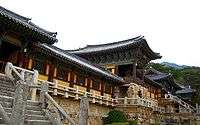Gija Joseon
Gija Joseon (1120–194 BC) refers to the period of Gojoseon following the alleged arrival of the sage Gija. As with Dangun, concrete evidence for Gija's role in the history of Gojoseon is lacking, and the narrative has been challenged since the 20th century.
| Gija Joseon | |||||||||
| Chinese name | |||||||||
|---|---|---|---|---|---|---|---|---|---|
| Traditional Chinese | 箕氏朝鮮 | ||||||||
| Simplified Chinese | 箕氏朝鲜 | ||||||||
| |||||||||
| Korean name | |||||||||
| Hangul | 기자조선 | ||||||||
| Hanja | 箕子朝鮮 | ||||||||
| |||||||||
Part of a series on the |
||||||||
|---|---|---|---|---|---|---|---|---|
| History of Korea | ||||||||
 | ||||||||
| Prehistoric period | ||||||||
| Ancient period | ||||||||
|
||||||||
| Proto–Three Kingdoms period | ||||||||
| Three Kingdoms period | ||||||||
|
||||||||
| Northern and Southern States period | ||||||||
|
||||||||
| Later Three Kingdoms period | ||||||||
|
||||||||
| Dynastic period | ||||||||
|
||||||||
| Colonial period | ||||||||
|
||||||||
| Modern period | ||||||||
|
||||||||
| Topics | ||||||||
| Timeline | ||||||||
.jpg)
| Monarchs of Korea | ||||||||||||||||||||||||||||||||||||||||||||||||||||||||||||||||||||||||||||||||||
| Gija Joseon | ||||||||||||||||||||||||||||||||||||||||||||||||||||||||||||||||||||||||||||||||||
|---|---|---|---|---|---|---|---|---|---|---|---|---|---|---|---|---|---|---|---|---|---|---|---|---|---|---|---|---|---|---|---|---|---|---|---|---|---|---|---|---|---|---|---|---|---|---|---|---|---|---|---|---|---|---|---|---|---|---|---|---|---|---|---|---|---|---|---|---|---|---|---|---|---|---|---|---|---|---|---|---|---|---|
|
||||||||||||||||||||||||||||||||||||||||||||||||||||||||||||||||||||||||||||||||||
Understanding before 20th century
Chinese records before the 3rd century BC describe Gija (箕子) as the paternal uncle (or brother in other records) of the last emperor of the Chinese Shang Dynasty, the tyrannical King Zhou, but contain no mention of his relationship with Gojoseon. Gija was imprisoned by the tyrant until the downfall of Shang Kingdom, when King Wu of Zhou released him.
Records written after the 3rd century BC, when China and Gojoseon were at war, add that Gija led 5,000 to the east of present-day Beijing, as written in the Geography of Hanshu from the Han Dynasty (though some, especially in China, believe him to have moved to present-day Korea), and became the king of Gija Joseon.
It is widely believed that Gija Joseon was located in present-day Korea, replacing Gojoseon of Dangun. But some Korean scholars believe that Gija settled west of Gojoseon, based on records from Geography of Hanshu, and the Korean Samguk Yusa that suggests that Gojoseon continued to coexist with Gija Joseon after the migration of Gija. These scholars believe that Gija's influence was limited to western part of Gojoseon. Furthermore, the record in Samguk Yusa,
Later Dangun moved his capital to Asadal on T'aebaek-san and ruled 1500 years, until king Wu of Chou (ancient Chinese dynasty) placed Kija on the throne (traditional date 1122 BC). When Kija arrived, Dangun moved to Changtang-kyong and then returned to Asadal, where he became a mountain god at the age of 1908. (Ilyon, Samguk Yusa, translated by T. Ha & G. Mintz (1997), Yonsei University Press, p.33)
(御國一千五百年. 周虎{武}王卽位己卯, 封箕子於朝鮮, 壇君乃移於藏唐京, 後還隱於阿斯達爲山神, 壽一千九百八歲),
and in Sima Qian's Shi Ji that
King Wu enfeoffed Gija to Joseon, though he was not a vassal (of Zhou)
(於是武王乃封箕子於朝鮮而不臣也).
suggests that Gija's role in ancient Korean history was limited.
The Genealogy of the Cheongju Han Clan (청주한씨세보) lists the names of 73 rulers of Gija Joseon and their periods of reign; however, it is not widely accepted by current Korean mainstream historians.
Wiman Joseon is said to begin with the usurpation of the throne from Jun of Gojoseon and the line of kings descended from Gija.
Shin Chaeho's opinion
Shin Chaeho said that Gija Joseon (323 BC-194 BC) refers to the putative period of Beonjoseon, one of the Three Confederate States of Gojoseon, after Gihu (기후, 箕詡) became the king of Beonjoseon. Chinese traditional accounts indicate that Gihu's ancestor, Gija, was the same person as Jizi (both written as 箕子 in Hanzi/Hanja).
According to Sin Chaeho's Joseon Sangosa, Beonjoseon began disintegrating after its king had been killed by a rebel from the Chinese state of Yan at around 323 BC. With this, the five ministers of Beonjoseon began contending for the throne. Gihu joined in this struggle, and emerged victorious as the new king of Beonjoseon, defeating the competitors for the throne. He established Gija Joseon, named after his ancestor Gija. During Gija Joseon, the king enjoyed strong sovereign powers. Eventually, in 94 BC, Gija Joseon fell after King Jun was overthrown by Wiman, who established Wiman Joseon in its place.
Controversy on whether Gija and Jizi were the same person
Historian Kim Jung-bae claims that the association between Jizi and Joseon is wrong.[1] He believed that the existence of Gija Joseon as a state established by Jizi was fabricated during Han Dynasty. He further claims that the Bamboo Annals, and Confucius's Analects, which was the earliest extant text that referred to Jizi, did not say anything about his going to Gojoseon.[2] Similarly, the Records of the Grand Historian, written soon after the conquest of Wiman Joseon by Han, made no reference to Joseon in its discussions about Jizi[3] and no reference to Jizi in its discussions about Joseon.[4]
According to some sources, ancient Koreans claimed that Gija came from the Zhou dynasty but there is no archaeological evidence to support early involvement of the Chinese.[5]
See also
- History of Korea
- List of Korea-related topics
- Cheongju Han clan
- Haengju Ki clan
- Taiyuan Sunwoo clan
- Icheon Seo clan
References
- http://www.dbpia.co.kr/view/ar_view.asp?pid=694&isid=30674&arid=657709&topMenu=&topMenu1=
- Analects, vol. 18.
- Records of the Grand Historian, vols. 3, 4.
- Records of the Grand Historian, vol. 115.
- Ebrey, Patricia Buckley; Walthall, Anne (2013-01-01). Pre-Modern East Asia: A Cultural, Social, and Political History, Volume I: To 1800. Cengage Learning. ISBN 9781285546230.